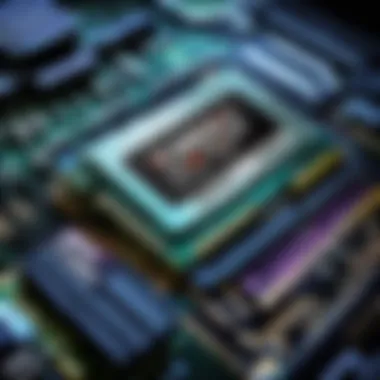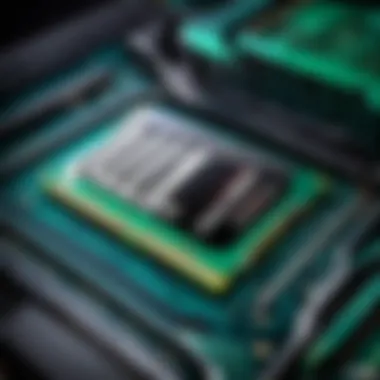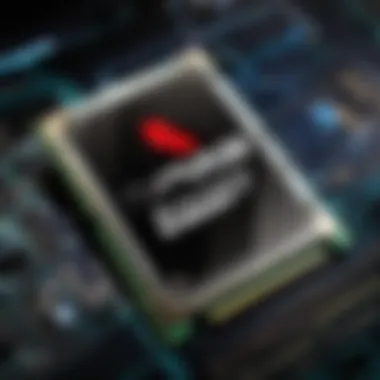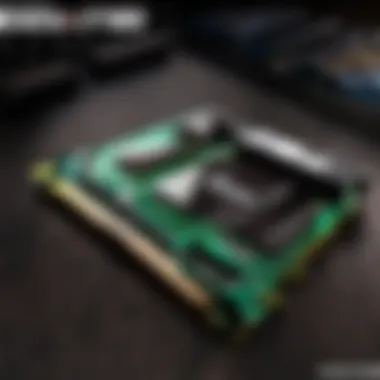Decoding DDR3 2GB RAM Pricing Trends and Influences


Intro
The landscape of DDR3 2GB RAM pricing is influenced by various factors that intertwine market trends, performance metrics, and consumer requirements. This exploration aims to offer a coherent understanding of how these components shape the pricing dynamics of DDR3 2GB RAM.
Game Overview
Prologue to DDR3 2GB RAM
DDR3 2GB RAM serves a specific segment of the computing market. This type of RAM has been widely utilized in mainstream desktops and laptops. It provides a balance between performance and price, making it appealing for users with moderate computing needs. One key feature is its supporting capabilities for multitasking and handling basic applications effectively.
Performance Characteristics
While DDR3 technology may seem dated compared to newer versions, it is still relevant in many budget-oriented setups. The speed, measured in megahertz, and latency significantly influence its operational efficiency. Users looking for quick load times and seamless transitions between applications often prioritize these metrics when selecting RAM.
Historical Context
DDR3 emerged in the late 2000s, succeeding DDR2, and offered enhanced performance. Over time, as higher generation RAM technologies like DDR4 gained popularity, the demand for DDR3 began to wane. Nonetheless, its affordability has allowed it to remain an option in the current market, especially in older systems.
The decline in manufacturing new DDR3 modules sometimes leads prices to fluctuate due to scarcity, affecting availability and overall pricing reliability.
Market Dynamics
Presently, the DDR3 RAM pricing landscape comprises several elements.
- Supply and Demand: As production slows, demand coupled with a dwindling supply can increase prices.
- Manufacturers: Various companies, such as Kingston, Crucial, and Corsair, compete in this niche, and their pricing strategies shape the market.
- Compatibility with Systems: Older machines often require DDR3 RAM which keeps some measure of demand alive.
- Performance vs Cost Equation: Users attempting to balance performance with their budget find DDR3 appealing, especially in context of cost-effectiveness.
In summary, the dynamics surrounding DDR3 2GB RAM pricing illuminate key concepts relevant not only to potential buyers but also to businesses monitoring inventory and sales amidst technological advancements. These elements paint a clearer picture of its market status. Understanding these factors can assist consumers in making more informed purchase decisions and perhaps spell out future inclinations in the computing market.
Overview of DDR3 RAM
The examination of DDR3 RAM is essential in understanding its role and impact on the pricing of computer hardware. This section outlines the significance of DDR3, emphasizing its features, functionalities, and how it compares with other memory types.
What is DDR3 RAM?
DDR3 RAM, or Double Data Rate Type Three Synchronous Dynamic Random Access Memory, is a prevalent form of memory used in various computers and devices. Manufcaturers designed it to improve speed and efficiency over its precedor DDR2. DDR3 doubles the data transfer rate and reduces power consuption, making it a suitable choice for both standard users and gamers. It operates with a bandwidth up to 17GB/s, enhancing system performance during memory-intensive tasks like gaming, graphic design, and software development.
Key Features of DDR3
Several distinguishing characteristics define DDR3 RAM:
- Speed: DDR3 can operate at frequencies of 800 to 2133 MHz, allowing faster data processing.
- Power Efficiency: Typically runs at 1.5V or less, leading to notable energy savings compared to DDR2.
- Scalability: Supports up to 64GB capacities per module, facilitating greater multitasking and improved system stability.
These features explain why DDR3 remains relevant, even as newer RAM types emerge.
Comparison with DDR2 and DDR4
When comparing DDR3 with DDR2, the advancements in speed, bandwidth, and power efficiency become evident:
- Speed Difference: DDR3 generally operates at higher frequencies than DDR2, which impacts performance significantly in data-intensive applications.
- Power Consumption: DDR3’s lower voltage translates to less electrical use capitalizing on efficiency during computing tasks.
Conversely, DDR4 offers further improvements over DDR3:
- Higher Data Rate: DDR4 outspeeds DDR3 by enabling higher frequencies, up to 3200 MHz and beyond.
- Efficiency and Capacity: DDR4 can utilize voltages as low as 1.2V and supports greater memory capacities, preferred in modern high-performance systems.
This analysis illustrates the evolutionary path of RAM technology and provides insight into the current RAM market landscape.
Market Overview of DDR3 2GB RAM


The market overview of DDR3 2GB RAM offers critical insights into its pricing dynamics. Understanding this concept is vital for consumers, manufacturers, and suppliers alike. This segment of the article sheds light on price movements, influencing factors, and general market trends. A detailed overview helps all stakeholders make informed decisions, particularly in understanding how pricing impacts user accessibility and technology adoption.
Current Price Trends
Current price trends for DDR3 2GB RAM reflect a market that has gone through fluctuations driven by multiple elements. Prices are not static; they are influenced by availability, demand cycles, and global economic conditions. Reports indicate that recently, pricing has stabilized compared to previous spikes often influenced by geopolitical factors and production shipment delays.
Using resource data from popular online retail platforms, we observe that most units of DDR3 2GB RAM show competitive pricing averaging around $15 to $30. In terms of trends, prices have exhibited a slight decline thanks to numerous manufacturers ramping up production, creating a surplus.
Additionally, various sales periods, like Black Friday or back-to-school promotions, can also affect pricing significantly. It's crucial to watch those periods for potential deals. Overall, current prices present both challenges and opportunities in understanding the broader context of the RAM market.
Historical Price Analysis
Analyzing historical price movements ensures a full spectrum understanding of DDR3 2GB RAM. By looking at trends over the last few years, noticeable patterns emerge. For instance, prices peaked notably in 2017 due to high demand from both consumers and industrial needs. However, this hunger for DDR3 started diminishing with the advent of DDR4, leading to a subsequent decrease in prices.
Graphs and datasets reveal that from 2018 to 2020, prices underwent significant dropping, seated around 50% lower than the previous peaks. Factors for these reductions include increased competition from both local and international suppliers, as well as advancements in manufacturing technologies that improve yield rates.
Furthermore, significant product releases from prominent brands like Kingston and Crucial have shifted the market landscape, driving prices down further and creating new benchmarks for pricing standards. Consistently monitoring the price history can assist gamers and other users in identifying reasonable buy points, rather than dealing with inflated prices during high-demand periods.
To do an informed purchase, study past prices as much as current prices. Historical trends shape understanding of what constitutes realistic pricing in the RAM sector.
Factors Influencing DDR3 2GB RAM Prices
Understanding the factors influencing DDR3 2GB RAM prices is essential in recognizing the intricacies of the market. These prices are not just arbitrary numbers but are shaped by various elements that include supply and demand, technological developments, and competition among manufacturers. By getting a grasp on these components, buyers can make more informed decisions while purchasing RAM, allowing them to effectively match performance expectations with their budgetary constraints.
Supply and Demand Dynamics
Supply and demand play a critical role in determining the price of DDR3 2GB RAM. The basic economic principle states that when supply exceeds demand, prices tend to fall, and conversely, when demand outstrips supply, prices rise. In recent years, DDR3 RAM has experienced fluctuating demand due to the growth of the budget PC market, which tends to select DDR3 over newer alternatives as a cost-saving measure.
- Increased demand from users looking to upgrade older systems also pushes prices up.
- On the other hand, if production ramps up or newer generations of RAM become available, DDR3 2GB prices may become more favorable.
Thus, it's a constant balance within supply chains, reflected in market prices which can adjust considerably in response to these underlying factors.
Technological Advancements
Technological advancements continually shape the landscape of DDR3 RAM pricing. As newer RAM types, such as DDR4 and even DDR5, gain market traction, manufacturers often direct resources toward these emerging technologies. Consequently, the techniques used in the production of DDR3 RAM may take a backseat. This shift on focus can lead to a reduction in the available inventory for DDR3 RAM, potentially creating higher prices due to limited supply. Moreover, new processes to enhance manufacturing efficiency can contribute to overall price changes. Several factors come into play here, including:
- Improvements in the semiconductor industry, which may reduce production costs for older RAM types, resulting in a price adjustment.
- Consumer interest in gaming and high-performance computing has shifted slightly towards RAM variants that hold better speed and capacity.
Ultimately, with rapid technological shifts in hardware, consumers who keep their thumb on the pulse of cutting-edge innovations can anticipate the ebb and flow in DDR3 2GB RAM prices.
Market Competition
Market competition is integral to understanding DDR3 2GB RAM pricing dynamics. Numerous manufacturers, including names like Kingston, Crucial, and Corsair, vie for market share in this segment, each trying to provide the best value possible to consumers.
- Healthy competition often leads to lower prices since producers compete to attract customers.
- However, if only a few players dominate the market, prices may remain high as competition decreases.
Additionally, promotions, discounts, and innovative offers can provide advantageous opportunities for consumers. Keeping a close eye on competitors’ moves can help buyers snag the best deals while ensuring they are purchasing quality components.
Understanding the Cost of DDR3 2GB RAM
The cost of DDR3 2GB RAM is a pivotal aspect when analyzing the dynamics of the fast-evolving memory market. Understanding this cost is essential for various stakeholders, including casual gamers, competitive players, and enthusiasts looking to optimize their systems. This section will break down the important components contributing to the overall pricing and assess how brand perception shapes these figures.
Components of Pricing
The pricing of DDR3 2GB RAM involves multiple elements that interact to determine market value. Within this multifaceted structure, often overlooked components play, crucial roles:
- Raw Material Costs: Elements like silicon and other materials used in memory chips have inherent variances in price. Supply chain fluctuations can greatly influence overall costs. If material sources become scarce or demand surges, prices will inevitably rise.
- Manufacturing Processes: The costs of producing DDR3 RAM can vary between manufacturers, depending on technology investments and efficiency. For instance, companies investing in advanced production lines may achieve cost savings that support competitive pricing.
- Distribution Expenses: Once manufactured, the RAM must be delivered to retailers and customers. Shifts in transportation costs—due to geopolitical tensions or fuel prices—can influence final retail prices.
- Market Demand: Variability in demand can also impact cost. In trends where high-performance PCs peak in popularity, demand may quickly exceed supply, driving up prices. Seasonal purchasing trends often compound these issues further.


In essence, these multifaceted pricing components collaboratively shape the market cost of DDR3 2GB RAM. Each element possesses its dynamics, contributing to final pricing in distinct ways.
Impact of Brand on Price
Brand plays a significant role in the pricing structure of DDR3 2GB RAM. The perception of a brand often translates into consumer trust and willingness to pay. Established manufacturers such as Kingston, Corsair, and Crucial often command higher prices due to their reputable histories and quality assurances.
High-frequency benchmarking and testing certifications lend credence to these brands, allowing them to justify higher prices as a reflection of quality. Furthermore, brands often tailor pricing strategies focusing on:
- Perceived Value: Higher rates may reflect not just the product's performance but also its associated prestige within the gaming or tech community. Many consumers are willing to invest in a reputed brand despite the availability of less expensive alternatives.
- Warranty and Support Services: Companies like G.Skill Midnight offer robust warranties and customer support for their products. Users may consider these parameters paramount and justifiable when considering brand costs.
- Packaging and Marketing: Innovative marketing strategies aimed at tech-savvy audiences can create a perception of value that enhances pricing policies. Effective branding may lead an individual to associate performance with higher prices intentionally.
It's critical to recognize that while brand influence significantly impacts pricing, consumers must also assess the practicality of their investments by comparing performance attributes against the price differences. Ultimately, informed purchasing decisions stem from considering both performance capabilities and the subtleties inherent to brand pricing psychology.
Value Proposition of DDR3 2GB RAM
In the landscape of computing, evaluating the value proposition of DDR3 2GB RAM is crucial for a variety of users, especially casual gamers and competitive players. Value proposition refers not only to the cost but the benefits and utility it provides in practical terms.
Usage Scenarios
DDR3 2GB RAM is suitable for various environments. For example, it can serve well in older systems where light computing tasks are involved. This includes basic web browsing, word processing, and the running of lighter software applications. In these cases, the RAM can provide the functionality needed without overspending on high-capacity alternatives. Additionally, in development scenarios, having DDR3 2GB RAM can be an adequate choice for testing apps on low-resource platforms. Here are some prime usage scenarios:
- Basic Office Tasks: Running software like Microsoft Office or Google Docs.
- Web Browsing: Multiple tabs for light browsing without heavy resource strain.
- Light Gaming: Play childhood or nostalgic games with moderate demands on the system.
- Educational Purposes: Installing educational software aimed at younger students.
Performance Expectations
Understanding the performance potential of DDR3 2GB RAM is crucial. While it may not compete at the same level as newer options like DDR4, it has specific areas where it flourishes. Users can expect stable performance for everyday tasks without significant lag. The relatively lower clock speed than DDR4 may influence heavy gaming when multitasking. Despite this, minimal multitasking can achieve satisfactory results.
Expectations align with key aspects:
- Speed: Offers decent operational speeds suitable for its intended applications without unnecessary burden.
- Energy Efficiency: DDR3 is known for reduced power consumption, making it environmentally friendly and potentially reducing electricity bills for everyday use.
- Affordability: At a lower price point compared to higher-capacity RAM options, DDR3 2GB RAM presents a worthwhile investment for budget-conscious buyers.
In summary, DDR3 2GB RAM holds significant value for users ranging from casual gamers to individuals looking for improved efficiency within basic systems. It lends itself well to practical situations while addressing the essential performance needs without overextension on resources or budget.
“The value of DDR3 2GB RAM translates not just in cost, but inits ability to meet fundamental demands of various user scenarios effectively.”
Comparative Analysis with Other RAM Variants
Understanding the dynamics of RAM pricing involves a thorough comparative analysis with other variants. This scrutiny becomes increasingly important when assessing DDR3 2GB RAM. Through this comparison, we can illuminate specific elements and benefits that influence consumer choices and market trends.
One noticeable differentiation is performance. Users often seek to allocate their budgets effectively, considering which RAM offers the most substantial improvements for their specific applications. Thus, comparing DDR3 with DDR4 is vital in elucidating the advancement in speed and efficiency that newer variants offer.
Moreover, looking into the cost implications of various RAM capacities allows us to recognize value propositions. Shoppers are frequently confronted with fluctuating prices across multiple designs and makes. Understanding these trends could further assist casual and competitive gamers in making informed decisions.
Among notable elements to assess, these should not be overlooked:
- Speed and Latency: Insights on terms like CAS latency will impact real-world application performance.
- Bandwidth: A comparison between DDR3’s data rate versus that of DDR4 shows crucial shifts in gaming and multitasking scenarios.
- Energy Efficiency: Newer DDR4 variants typically consume less power compared to DDR3, which goes for affordability over performance.
In summary, this comparative analysis serves as bedrock for the article's discussions, enhancing an understanding of DDR3 2GB RAM pricing in a wider context.
DDR4 vs DDR3 2GB
When comparing the DDR3 2GB RAM variant to its successor, the DDR4, several crucial aspects must be noted. DDR4 is progressively becoming a standard in the market. Its enhanced speed greatly impacts overall system performance.
- Speed: DDR4 typically operates at a higher data rate than DDR3 RAM. The nominal speed of DDR4 starts around 2133 MT/s, rising with variations, whereas DDR3 is usually limited to a maximum of 1600 MT/s.
- Energy Consumption: In practical terms, DDR4 requires less voltage to operate effectively. Compared to DDR3’s 1.5 volts, which can raise overall system heat output, DDR4’s lower energy requirement helps in maintaining system thermal levels and boosts device longevity.
- Cost: New inquiries into the pricing dynamics illustrate that while DDR4 may be more expensive initially, the value derived from enhanced performance proves beneficial in the long run. Collectively, the cost may seem higher, but savings in power may offset that in time.
- Applications: Those focusing heavily on gaming or demanding multitasking often find DDR4's advancements a fitting investment. An upgraded system using DDR4 makes it future-proof, thereby extending its functional lifespan significantly.
As newer applications that demand increasing resources arrive, recognizing the essential differences between DDR3 and DDR4 is crucial.
Price Comparison with Other Capacities


Examining price structures across various capacities reveals complexities in DDR3 2GB RAM valuation. Shoppers gearing towards 2GB may question,
Future Pricing Trends for DDR3 RAM
Understanding future pricing trends for DDR3 RAM is crucial for both consumers and industry stakeholders. As technology evolves, the demand for DDR3 continues to change, causing fluctuations in pricing. Anticipating these trends allows consumers to make informed decisions while optimizing their purchases.
Market Predictions
The market predictions for DDR3 2GB RAM pricing largely depend on several intertwined factors. These include trends in supply chain stability, shifts in consumer preferences, and comparative pricing against newer technologies like DDR4. Analysts expect potential decreases in prices of DDR3 RAM in the coming year as manufacturers direct more resources towards producing DDR4. However, the viability of DDR3 in older systems cannot be overlooked. Many users still rely on DDR3, maintaining market demand that could stabilize prices midway through the transition.
Moreover, trends in global electronics demand and shortages in semiconductor supply could play critical role in price variations. If shortages arise that can impact production, expect jittery prices in the short term.
"Market predictions for DDR3 RAM pricing involve understanding historical trends and recognizing future consumer needs."
In summary, while overall prices may stabilize once DDR4 reaches widespread adoption, short-term volatility may be a notable aspect for DDR3, which could benefit those looking to make purchases now.
Impact of Emerging Technologies
Emerging technologies invariably affect DDR3 pricing dynamics. Technologies like DDR5 are approaching maturity, while DDR4 continues to increase its market share. These changes push mode seen technologies like DDR3 to a relevant but secondary position.
The rise of Artificial Intelligence and cloud computing increases the need for high-performance RAM components. This may simultaneously impact pricing; as newer generations gain traction, DDR3 may face significant price depressions. On the flip side, if consumers keep older systems in use, DDR3 might sustain prices due to a forecast demand in refurbishment markets.
Factors like energy efficiency improvements, low latencies in new models, as well as manufacturing innovations may breathing in more competitive networks overall in component dynamics. A balance between development in newer products and continued support for the legacy install base will shape DDR3 prices in fascinating ways.
Investors and consumers should constantly monitor these recent trends to understand the interconnected web of influences that drive the DDR3 price landscape.
Consumer Perspectives on DDR3 2GB RAM Pricing
Understanding consumer perspectives on DDR3 2GB RAM pricing is critical for grasping the overall market dynamics. Consumers are not just passive participants; they actively influence trends through their purchasing decisions. By understanding what drives these decisions, we can better analyze current market behavior and forecast future pricing strategies.
Buying Considerations
When considering the purchase of DDR3 2GB RAM, consumers often evaluate several factors which significantly influence their choices. The performance of the RAM module, compatibility with existing hardware, brand reputation, and service options all play vital roles.
- Use case: Casual users might prioritize should focus on basic tasks and lighter applications, while gamers or content creators typically seek faster modules for enhanced performance in demanding environments.
- Price vs. performance: Consumers continually assess whether the advantages in speed and responsiveness justify the price premium compared to alternatives like DDR4. Understanding user needs and performance scenarios can provide insight into pricing expectations.
- Durability and warranty: Reliable warranty and customer service greatly affect purchasing decisions. Experienced users prefer modules with favorable return and service policies.
In purchasing DDR3 2GB RAM, these considerations may lead to higher demand and increased willingness to pay quote increases. Therefore, understanding these driving factors can assist marketers and manufacturers in adjusting their pricing methods.
Feedback from Users
User feedback often serves as a valuable source of information for potential buyers. Reviews and recommendations allow consumers to gauge the practical experience of others before making their own purchases. Some key points from user experiences include:
- Performance Satisfaction: Users commonly share opinions on whether the RAM performed as expected in real-world applications. Performance can greatly differ from benchmarks. Consumers appreciate feedback offering insights related to actual use.
- Installation and Compatibility: Installation errors often spark concern among buyers. An easier installation process can greatly influence market perception and feedback, reflecting user confidence in technical compatibility.
- Longevity and Reliability: Long-term satisfaction is frequently highlighted in user reviews. Drivers and firms providing unexpected reliability gain more satisfied users willing to advocate for their products.
User experience shapes opinions. Positive feedback can lead to trust important in purchasing decisions.
By emphasizing detailed advice from genuine users, potential buyers can make informed decisions rooted in reality, steering clear of hype and misconceptions commonly found in advertising.
The complexities and interactions of consumer behaviors will continue to influence DDR3 2GB RAM prices, reflecting the overall demand and attraction for certain offerings.
Closure
In this article, we explored the multifaceted aspects of DDR3 2GB RAM pricing and its implications for different stakeholders in the market. As consumers, gamers, or even industry professionals, understanding these dynamic factors can be highly beneficial. The discussion revolved around how current market trends, technological advancements, and historical pricing data influence the overall cost of DDR3 RAM.
Implications for Buyers
Buyers must consider several factors when evaluating DDR3 2GB RAM. It is crucial to acknowledge how pricing fluctuates due to various market pressures, such as supply and demand. Additionally, the performance characteristics of RAM and how they align with intended uses should influence purchasing decisions. By being aware of brand impacts on price and performance, consumers can tailor their choices to fit specific requirements, ensuring they optimize their investments. Factors like warranty and aftermarket support also need to be factored into the buying considerations, as these often correlate with long-term satisfaction.
- Look at historical prices to anticipate future trends.
- Research brand reputation alongside performance metrics.
- Make informed decisions by weighing user feedback and benchmarks.
Final Thoughts
The final reflections on DDR3 2GB RAM pricing emphasize its relevance in today's technology landscape. As systems continue to evolve, DDR3 RAM will likely play a less prominent role. Nevertheless, its affordability and now extensive usage in budget systems illustrate its ongoing significance. Gamers and casual users alike can potentially maximize value by taking calculated risks in their purchasing strategies. Gathering comprehensive knowledge about market dynamics will enable buyers to navigate the ever-changing landscape of computer hardware effectively. RAM is not merely a commodity; its understanding assures a more novel experience in any technological endeavor.
“The informed buyer navigates technology not just with need, but with insight.”



